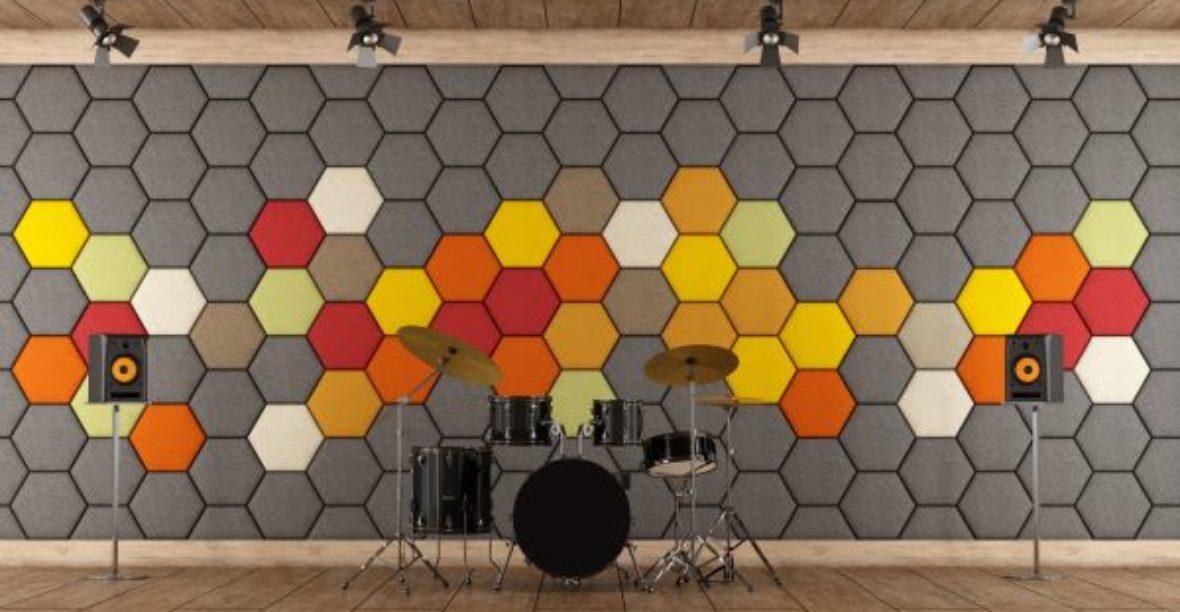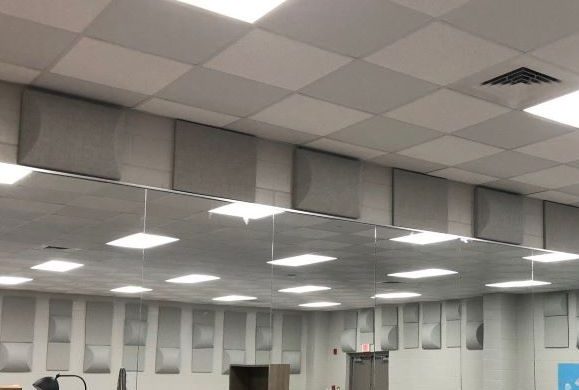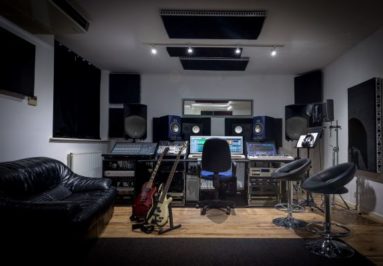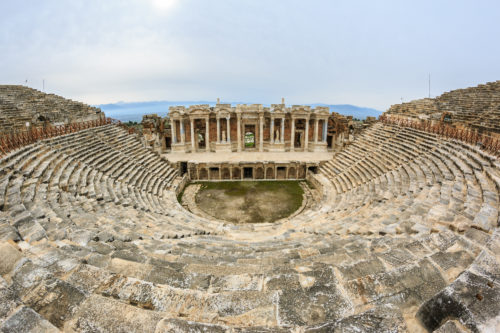Types of Acoustical Absorption Panels
When you think of acoustical absorption panels, you might only picture the standard 2″ thick 2’x4′ that you’d see in recording studios, restaurants or churches, but acoustic wall panels are actually available in a number of shapes, sizes and materials.
The most common acoustic absorption panels are typically made from a 6 pcf fiberglass, but other materials can include Recycled Polyester, Cementitious Wood Fiber, Perforated Wood, and even Perforated Wood.
Prefabricated Panels vs Field Fabricated Acoustic Panels
Prefabricated acoustical panels are made using a core, either 1″ or 2″ in thickness, and are wrapped in acoustically transparent fabric. Fiberglass cores are most commonly 6-7 pcf, but can be 3 pcf in certain circumstances. They have similar performance acoustically, but 6 pcf cores can be risen hardened and a layer of impact resistance can be added to the face (which is a 16 PCF 1/8″ thick layer).
The most popular brand of acoustic fabric is Guilford of Maine, but some other higher end brands include Designtex, Maharam, Luum, Wolf Gordon and others. Certain acoustic fabric can also be printed on using a process called dye-sublimation, with high quality images, so that acoustic panels can be art-wrapped.
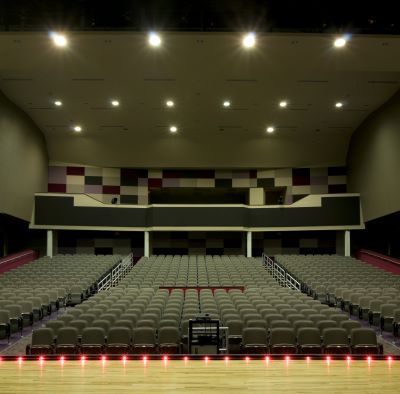
Although prefabricated panels aren’t meant to be modified in the field, they can be if needed. This would required unwrapping the panel, cutting the edge using a table saw and then re-adhering the fabric to the panel. Prefabricated panels are generally fastened to the wall using impaling clips or z-clips.
Field fabricated acoustic panels, commonly known as Stretched Fabric Wall, is a stretch fabric system that’s essentially identical to fiberglass panels, except that it may be built around obstructions or penetrations in the field. This is most appropriate when panels are extended from floor to ceiling, wall to wall, or numerous penetrations occur on the partition.
Ceiling Panels: Clouds vs Baffles vs Direct Mounts
Acoustic ceiling panels are always prefabricated, but they can be hung in a few different ways
- Ceiling Clouds
- Ceiling Baffles
- Direct Mount Ceiling panels
Acoustic ceiling clouds are generally constructed using the 2″ thick core, and wrapped in acoustically transparent fabric. As the name tells you, ceiling clouds hang down from the ceiling horizontally. Rotofast Anchors are screwed into the back of the panel and a metal eyelet is attached to the ceiling, then the panel is attached using metal hooks.
The cloud-style mounting method allows more surface area of the panel to be available for more sound absorption. It’s also a necessary mounting method for corrugated metal ceilings, since you couldn’t do a direct-mount on those.
Acoustic ceiling baffles are similar to ceiling clouds, whereas the full surface area of the panel is available for absorbing sound, but they hang vertically. This mounting method is mainly for spaces with high ceilings such as office lobbies, gymnasiums and some restaurants. Baffles are generally hung from the ceiling using airline wire that attaches to metal brackets along the top edge of the panel.
Direct ceiling mounted panels are directly attached to the ceiling also using a Rotofast Anchor, but the anchors screw in flush to the back of the panel. The other part of the anchor is attached to the ceiling, and the panel can be snapped into place. Direct mounts are usually used in spaces with flat gypsum or concrete ceilings, and allow for the panels to blend into a space better.
Specialty Sound Absorbing Materials
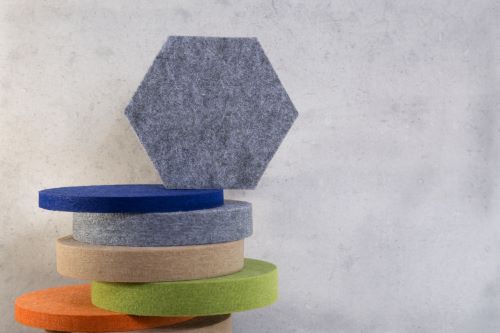
Other specialty sound absorbing panels and materials are typically more decorative than functional, and include, but are not limited to the following:
PET, or recycled polyester, and Felt acoustic panels are more decorative, and only appropriate for small conference rooms, team rooms or phone rooms. They’re typically available in 1/2″ and 1″ thicknesses and don’t have very high NRC ratings. There’s no need to wrap PET panels in acoustically transparent fabric because the polyester is already dyed to the desired color.
Felt and PET panels are normally field cut with a razor blade or circular saw and then fastened wall with construction adhesive, such as Loctite or Liquid Nails.
Melamine foam panels are typically used in DIY home studio projects, since they’re more affordable and more convenient to hang than fiberglass or PET panels. They can be fire rated or not, but are not meant for industrial use, as they will break down or degrade over time. Also, they have much lower NRC ratings than fabric-wrapped fiberglass panels and won’t be as effective for sound absorption.
Foam, usually melamine foam, open silver is closed to sell. The diy, seen in in home music studios. Fire rated, classic, just like felt or fiberglass panels. Generally not industrial use, as they will break or degrade over time. NRC is also lower than fabric wrapped fiberglass or felt acoustical panels.
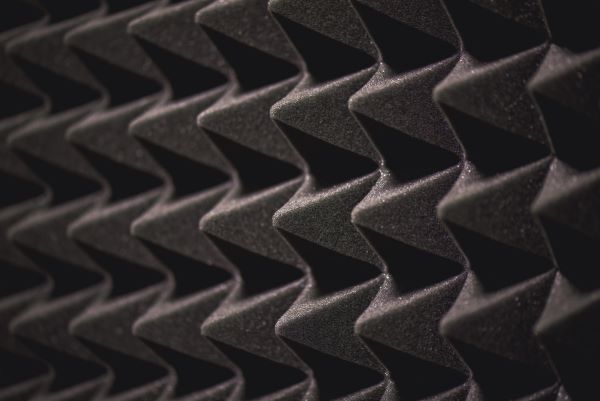
Cementitious wood fiber panels, such as Tectum are heavy-duty, and preferable for high impact areas. Tectum type panels are usually cut in the field using a table saw, hung and then painted. They generally require a Type E Mount with airspace behind it, filled with fiberglass insulation. The hardness of cementitious panels competes with the impact resistance versions of the fiberglass acoustical panels.
Perforated panels from companies such as Rulon or Topakustik are typically used in very high end spaces. Wood panels are generally about 1″ thick and have a veneer of the desired wood type. Since wood doesn’t have as high an NRC as fiberglass panels, they’re typically mounted with an air gap, and fiberglass insulation is used to fill the gap.
Who Installs Most Acoustical Panels?
Who manufactures acoustic wall panels?
Acoustic wall panels can be purchased retail right here at Soundproof Direct. For large quantities, Commercial Acoustics fabricates their Ekko Eraser line of acoustic wall panels baffles and clouds, and their Ekko Felt panels. Golterman & Sabo are manufacturers similar products in the Midwest US, and supplies them nationally.
Where to Use Different Panel Types
- Fabric Wrapped Fiberglass Panels: These should be used in auditoriums, restaurants, speaking halls, and performing art venues. Basically, anywhere performance and aesthetics are critical.
- PET/Recycled Polyester Panels: These should be used in small conference rooms, phone rooms, team huddle areas, and other small spaces where echo is not significant, but minor improvement is desired. These are used at eye level, so aesthetics are more critical than functionality.
- Foam Panels: Typically used for DIY or custom residential projects. They are similar and function to fiberglass panels, but have lower durability and a more industrial look.
- Cementitious Panels: These can be used in restaurants, or locations where cleaning is common, and damage to the panels is likely. Similar to the impact resistant fiberglass panels, but with a lower NRC, so you will need two to three times as much square footage for treatment.
Types of Acoustical Absorption Panels – Summarized
Different acoustic panel types include Fabric Wrapped Fiberglass Panels, PET/Felt Panels, Foam Panel, Cementitious Panels, Foam Panels, plus a few others. Depending on the space, different types of panels will be used, but the best performing panel type in terms of echo reduction will always be Fabric Wrapped Fiberglass Panels.

